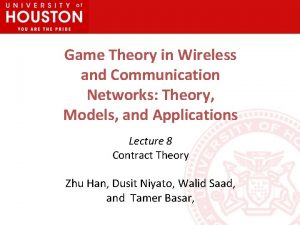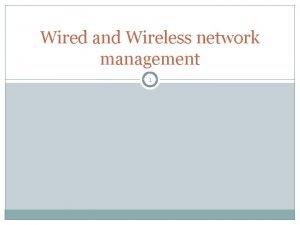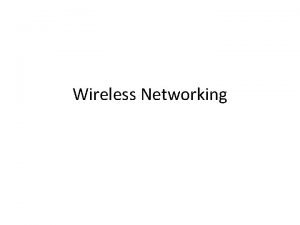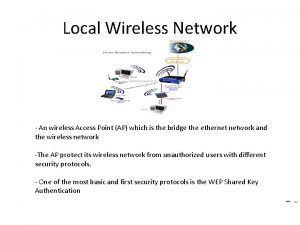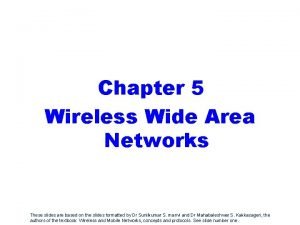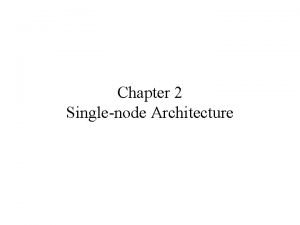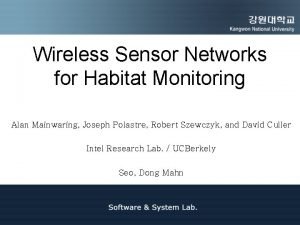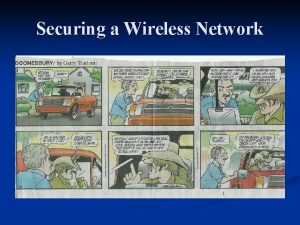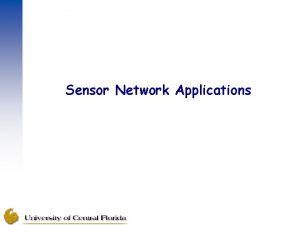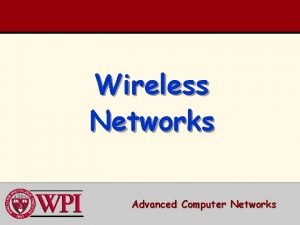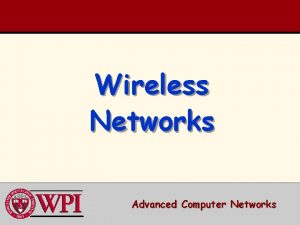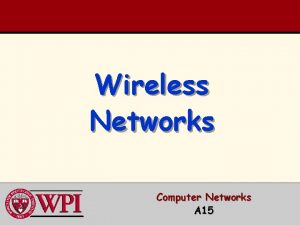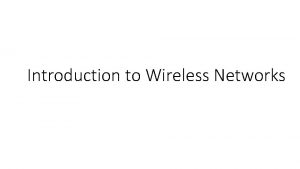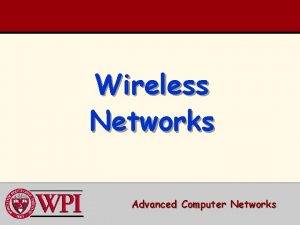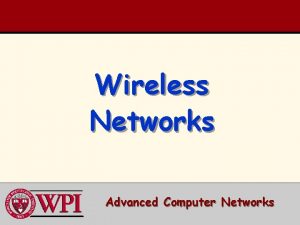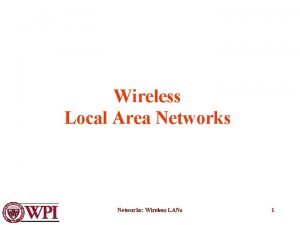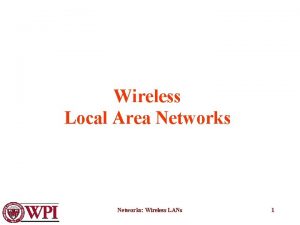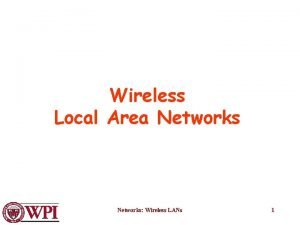Research and Test of NonIntrusive Wireless Networks for











- Slides: 11

Research and Test of Non-Intrusive Wireless Networks for Opportunistic Spectrum Utilization Univeristy Of California Davis PI: Zhi Ding (ECE) and Xin Liu (CS) Subaward: I-Jeng Wang, APL, Johns Hopkins Univ NSF Ne. TS Workshop 2006@UCLA

Project Goals and Scope § Investigating opportunistic access networks that can provide secondary service and are § spectrally-agile § non-instrusive to primary or legacy networks § low cost and broadly applicable § Collaborating with APL (JHU) to measure spectral activity of key target areas of the secondary network

ESCAPE: Embedded Spe. Ctrally Agile radio Protocol for Evacuation § Problem: § One or more users in a group may detect the return of primaries § To disseminate such information fast and reliably § § Interference from primary transmission Interference from regular secondary transmission No simultaneous transmission and reception In-band signaling § ESCAPE: § § PHY: predefined evacuation message using a given spreading code MAC: transmit as soon as the warning message is received Routing: flooding Performance metrics § Evacuation time, success probability, peak and average interference during evacuation, false-alarm rate § Design parameters § Spreading code length, power, number of repetition for a given objective § X. Liu, Z, Ding, Embedded Spe. Ctrally Agile radio Protocol for Evacuation, under submission.

Sensing-based Opportunistic Channel Access § To collaboratively detect whether a channel is idle and is a good opportunity § Is the channel “idle”? § Three proposed algorithms to make sensing decision so that the outage probability is below a certain threshold § Observation: collaborative sensing is very helpful § To do: more robust fading model and measurements with spatial correlation § Is the channel a good one; i. e. , to finish a transmission? § An algorithm based on channel sensing statistics. § X. Liu and S. Shankar, “Sensing-based opportunistic channel access”, ACM MONET, vol. 11, no. 4, August, 2006.

Data Collection at JHU/APL § § § Public safety band at Howard County, MD Two measurements suites, set at 5, 200, 600 meters apart Forward and reverse channels Objective: temporal and spatial correlation System setup: § The spectral data are sampled with 14 bits at 64 MS/s. § The samples are collected in snapshots of 16384 each, covering ~20 MHz every 100 ms. § This snapshot size allows for DFT bins of ~ 3. 9 k. Hz, which is enough resolution to discriminate between adjacent forward or reverse channels as their centers are never closer than 25 k. Hz.

5 meters apart fixed – site 1 mobile – site 1

10 d. B threshold fixed – site 1 mobile – site 1

Side-by-side – distance = 5 meters fixed - site 1 mobile - site 1

Current and Future Research Emphasis § Integrative studies of physical layer, MAC layer, and network layer § Performance evaluation and model validation. § Data collection, analysis, and public distribution § Feasibility and capacity analysis of 2 ndary network interacting with both non-interactive and interactive primary systems § Compatibility with CSMA-based primary users § Quantification of capacity and interference tradeoff

Links to other projects § § § Xin Liu (University of California, Davis) CAREER: Smart-Radio-Technology-Enabled Opportunistic Spectrum Utilization Dirk Grunwald, Doug Sicker, John Black (University of Colorado), Ne. TS-Pro. WIN: Topology And Routing With Steerable Antennas Uf Turelli, Kevin Ryan (Stevens Institute of Tech), Milind M. Buddhikot, Scott Miller (Lucent Bell Lab), Dynamic Intelligent Management of Spectrum for Ubiquitous Mobile Network (DIMSUMnet) Kang G. Shin, University of Michigan, Efficient Wireless Spectrum Utilization with Adaptive Sensing and Spectral Agility Qing Zhao, UC Davis, An Integrated Approach to Opportunistic Spectrum Access Randall Berry, Michael Honig and Rakesh Vohra, Northwestern University, Smart Markets for Smart Radios Mario Gerla, Stefano Soatto, Michael Fitz, Giovanni Pau, UCLA, Emergency Ad Hoc Networking Using Programmable Radios and Intelligent Swarms Saswati Sarkar, University of Pennsylvania, Dynamic Spectrum MAC with Multiparty Support in Adhoc Networks Marwan Krunz, Shuguang Cui, University of Arizona Resource Management and Distributed Protocols for Heterogeneous Cognitive-Radio Networks Dennis Roberson, Cindy Hood, Joe Lo. Cicero, Don Ucci (Illionis Institute of Technology), Uf Tureli (Stevens Institute of Technology) Wireless Interference and Characterization on Network Performance Narayan Mandayam, Christopher Rose, Predrag Spasojevic, Roy Yates, WINLAB Rutgers University, Cognitive Radios for Open Access to Spectrum

Links to other projects § Platform/Testbed projects § Dirk Grunwald (U. Colorado), John Chapin (Vanu, Inc), Joe Carey (Fidelity Comtech) A Programmable Wireless Platform For Spectral, Temporal and Spatial Spectrum Management § Jeffrey H. Reed, William H. Tranter, and R. Michael Buehrer, Virginia Tech, An Open Systems Approach for Rapid Prototyping Waveforms for Software Defined Radio § D. Raychaudhuri (WINLAB, Rutgers University) ORBIT: Open Access Research Testbed for Next-Generation Wireless Networks § B. Ackland, I. Seskar & D. Raychaudhuri, (WINLAB, Rutgers University), T. Sizer (Lucent Technologies), J. Laskar(GA Tech) High Performance Cognitive Radio Platform with Integrated Physical and Network Layer Capabilities § Babak Daneshrad, University of California, Los Angeles, Programmable/Versatile Radio Platforms for the Networking Research Community § Prasant Mohapatra, University of California, Davis, Quail Ridge Wireless Mesh Networks: A Wide Area Test-bed
 Advantages and disadvantages of wired and wireless networks
Advantages and disadvantages of wired and wireless networks Telecommunications, the internet, and wireless technology
Telecommunications, the internet, and wireless technology Game theory in wireless and communication networks
Game theory in wireless and communication networks Understanding wired and wireless networks
Understanding wired and wireless networks Datagram vs virtual circuit
Datagram vs virtual circuit Wireless networking meaning
Wireless networking meaning Local wireless networks
Local wireless networks Wireless wide area networks
Wireless wide area networks Single node architecture in wsn
Single node architecture in wsn Wireless sensor networks for habitat monitoring
Wireless sensor networks for habitat monitoring Wireless networks
Wireless networks Wireless sensor networks for habitat monitoring
Wireless sensor networks for habitat monitoring


